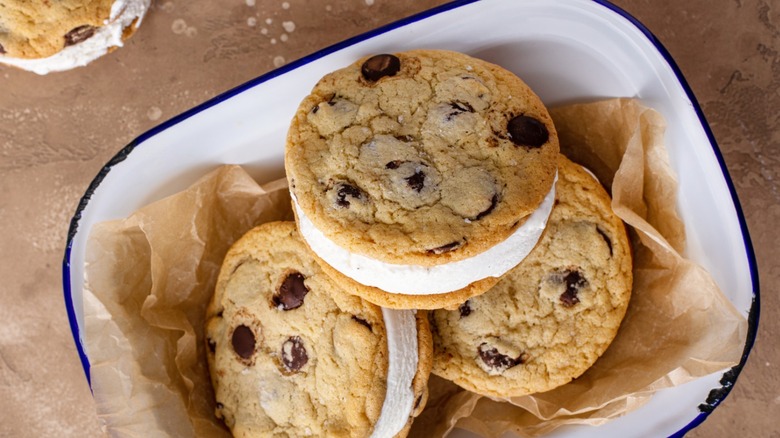For The Absolute Best Ice Cream Sandwich, Go For Warm Cookies
Nothing beats digging into an ice cream sandwich on a warm summer day, especially if the icy treat was made from scratch. Allowing for total customization, homemade ice cream sandwiches allow you to experiment with different combinations of cookies and ice cream flavors. Plus, you can even elevate your creations by dunking them into chocolate ganache or rolling them in colorful sprinkles. The one major drawback is that assembly isn't always the simplest nor cleanest — unless you warm the cookies beforehand.
To build the perfect ice cream sandwich, remember that opposites attract. Since cold ice cream and equally cold cookies are too stiff to unite, but warm ice cream and warm cookies risk dripping and crumbling, components must boast contrasting temperatures. Yet, while many believe that successfully crafting an ice cream sandwich depends on cooled cookies and softened ice cream, this method isn't without its faults. Cool cookies may prove brittle to the point of breaking, whereas softened ice cream can be too messy. A better solution is instead opting for warm cookies and cold ice cream.
By reversing their roles, the ingredients still manage to meet each other halfway, just more effectively. Essentially, soft cookies take on a chewy-yet-sturdy texture as they encounter a layer of frosty ice cream that melts ever so slightly, which adheres the cookies without the threat of excessive dripping. Naturally, the resulting ice cream sandwiches aren't only easier and mess-free to construct, but they also look and taste far superior.
How to keep cookies warm while keeping ice cream cold
Whether you work with homemade or store-bought cookies, warming them is essential to simplify the assembly process. When it comes to homemade biscuits, let freshly baked batches cool for a couple of minutes until they're no longer piping hot and can be handled without breaking. Alternatively, store-bought cookies can be warmed in the oven at 300° Fahrenheit for a mere minute to soften — even cookies baked days ago can be refreshed this way.
As for the ice cream, refrain from thawing. Instead, remove it from the freezer only once the sandwiches are ready to be built. Given that ice cream will be near-impossible to scoop, a sturdy spatula is the best tool to carve out thick slabs of ice cream. This will make extracting ice cream easier as well as rid you from having to forcefully press sandwiches together as flattened slices will fit in between cookies better than scooped mounds.
With cookies warmed and ice cream chilled, the main goal during assembly is to ensure components maintain their ideal temperature. Although prepping and refreezing ice cream slabs ahead of time can be a good starting point, working in small batches can also prove worthwhile. Another helpful tip is to transfer ice cream sandwiches back into the freezer as they're made so that they hold their shape and don't start to melt. Lastly, work quickly! Being speedy means you can enjoy ice cream sandwiches even sooner!

